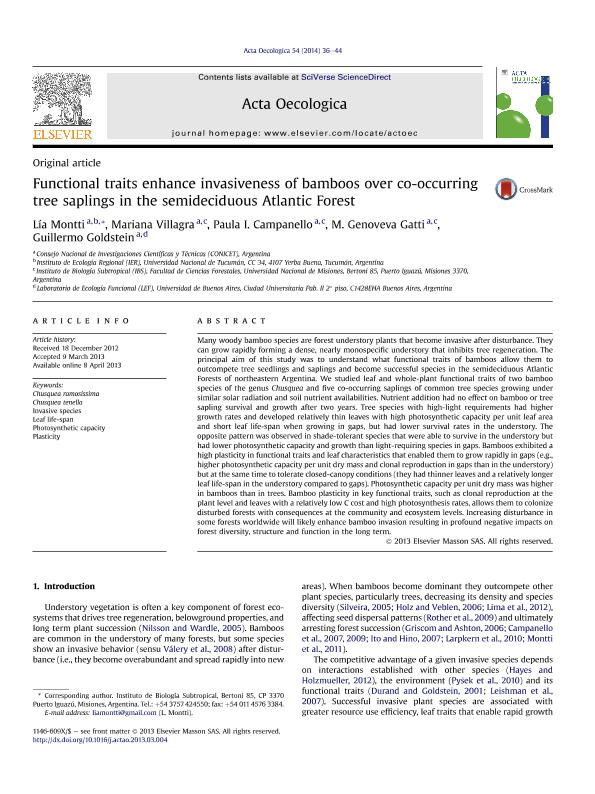Mostrar el registro sencillo del ítem
dc.contributor.author
Montti, Lia Fernanda

dc.contributor.author
Villagra, Mariana

dc.contributor.author
Campanello, Paula Inés

dc.contributor.author
Gatti, Maria Genoveva

dc.contributor.author
Goldstein, Guillermo Hernan

dc.date.available
2018-02-15T19:19:11Z
dc.date.issued
2014-01
dc.identifier.citation
Montti, Lia Fernanda; Villagra, Mariana; Campanello, Paula Inés; Gatti, Maria Genoveva; Goldstein, Guillermo Hernan; Functional traits enhance invasiveness of bamboos over co-occurring tree saplings in the semideciduous Atlantic Forest; Gauthier-villars/editions Elsevier; Acta Oecologica; 54; 1-2014; 36-44
dc.identifier.issn
1146-609X
dc.identifier.uri
http://hdl.handle.net/11336/36564
dc.description.abstract
Many woody bamboo species are forest understory plants that become invasive after disturbance. They can grow rapidly forming a dense, nearly monospecific understory that inhibits tree regeneration. The principal aim of this study was to understand what functional traits of bamboos allow them to outcompete tree seedlings and saplings and become successful species in the semideciduous Atlantic Forests of northeastern Argentina. We studied leaf and whole-plant functional traits of two bamboo species of the genus Chusquea and five co-occurring saplings of common tree species growing under similar solar radiation and soil nutrient availabilities. Nutrient addition had no effect on bamboo or tree sapling survival and growth after two years. Tree species with high-light requirements had higher growth rates and developed relatively thin leaves with high photosynthetic capacity per unit leaf area and short leaf life-span when growing in gaps, but had lower survival rates in the understory. The opposite pattern was observed in shade-tolerant species that were able to survive in the understory but had lower photosynthetic capacity and growth than light-requiring species in gaps. Bamboos exhibited a high plasticity in functional traits and leaf characteristics that enabled them to grow rapidly in gaps (e.g., higher photosynthetic capacity per unit dry mass and clonal reproduction in gaps than in the understory) but at the same time to tolerate closed-canopy conditions (they had thinner leaves and a relatively longer leaf life-span in the understory compared to gaps). Photosynthetic capacity per unit dry mass was higher in bamboos than in trees. Bamboo plasticity in key functional traits, such as clonal reproduction at the plant level and leaves with a relatively low C cost and high photosynthesis rates, allows them to colonize disturbed forests with consequences at the community and ecosystem levels. Increasing disturbance in some forests worldwide will likely enhance bamboo invasion resulting in profound negative impacts on forest diversity, structure and function in the long term. © 2013 Elsevier Masson SAS.
dc.format
application/pdf
dc.language.iso
eng
dc.publisher
Gauthier-villars/editions Elsevier

dc.rights
info:eu-repo/semantics/openAccess
dc.rights.uri
https://creativecommons.org/licenses/by-nc-sa/2.5/ar/
dc.subject
Chusquea Ramosissima
dc.subject
Chusquea Tenella
dc.subject
Invasive Species
dc.subject
Leaf Life-Span
dc.subject
Photosynthetic Capacity
dc.subject
Plasticity
dc.subject.classification
Otras Ciencias Biológicas

dc.subject.classification
Ciencias Biológicas

dc.subject.classification
CIENCIAS NATURALES Y EXACTAS

dc.title
Functional traits enhance invasiveness of bamboos over co-occurring tree saplings in the semideciduous Atlantic Forest
dc.type
info:eu-repo/semantics/article
dc.type
info:ar-repo/semantics/artículo
dc.type
info:eu-repo/semantics/publishedVersion
dc.date.updated
2017-02-13T20:31:02Z
dc.journal.volume
54
dc.journal.pagination
36-44
dc.journal.pais
Francia

dc.journal.ciudad
Paris
dc.description.fil
Fil: Montti, Lia Fernanda. Universidad Nacional de Tucumán. Instituto de Ecología Regional. Consejo Nacional de Investigaciones Científicas y Técnicas. Centro Científico Tecnológico Conicet - Tucumán. Instituto de Ecología Regional.; Argentina
dc.description.fil
Fil: Villagra, Mariana. Consejo Nacional de Investigaciones Científicas y Técnicas. Centro Científico Tecnológico Conicet - Nordeste. Instituto de Biología Subtropical. Universidad Nacional de Misiones. Instituto de Biología Subtropical; Argentina
dc.description.fil
Fil: Campanello, Paula Inés. Consejo Nacional de Investigaciones Científicas y Técnicas. Centro Científico Tecnológico Conicet - Nordeste. Instituto de Biología Subtropical. Universidad Nacional de Misiones. Instituto de Biología Subtropical; Argentina
dc.description.fil
Fil: Gatti, Maria Genoveva. Consejo Nacional de Investigaciones Científicas y Técnicas. Centro Científico Tecnológico Conicet - Nordeste. Instituto de Biología Subtropical. Universidad Nacional de Misiones. Instituto de Biología Subtropical; Argentina
dc.description.fil
Fil: Goldstein, Guillermo Hernan. Consejo Nacional de Investigaciones Científicas y Técnicas; Argentina. Universidad de Buenos Aires. Facultad de Ciencias Exactas y Naturales. Departamento de Ecología, Genética y Evolución. Laboratorio de Ecología Funcional; Argentina
dc.journal.title
Acta Oecologica

dc.relation.alternativeid
info:eu-repo/semantics/altIdentifier/doi/http://dx.doi.org/10.1016/j.actao.2013.03.004
Archivos asociados
